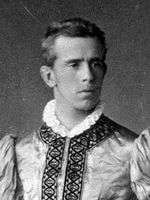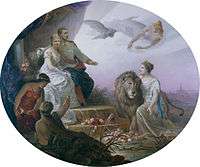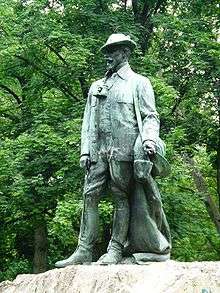Rudolf, Crown Prince of Austria
| Archduke Rudolf | |||||
|---|---|---|---|---|---|
| Crown Prince of Austria; Prince Royal of Hungary and Bohemia | |||||
 | |||||
| Born |
21 August 1858 Laxenburg, Austria | ||||
| Died |
30 January 1889 (aged 30) Mayerling, Austria-Hungary | ||||
| Burial | Imperial Crypt, Vienna | ||||
| Spouse | Princess Stéphanie of Belgium | ||||
| Issue | Elisabeth Marie, Princess Otto Weriand of Windisch-Grätz | ||||
| |||||
| House | Habsburg-Lorraine | ||||
| Father | Franz Joseph I | ||||
| Mother | Elisabeth of Bavaria | ||||
| Religion | Roman Catholicism | ||||
| Austrian Royalty |
| House of Habsburg-Lorraine |
|---|
.svg.png) |
| Francis I (Francis II, Holy Roman Emperor) |
|
| Ferdinand I |
| Franz Joseph I |
|
| Charles I |
|
Rudolf (21 August 1858 – 30 January 1889), who was Archduke of Austria and Crown Prince of Austria-Hungary, was the only son of Emperor Franz Joseph I and heir apparent to the Austro-Hungarian Empire from birth. In 1889, he died in a suicide pact with his mistress, Baroness Mary Vetsera, at the Mayerling hunting lodge.[1] The ensuing scandal made international headlines. He was named after the first Habsburg Holy Roman King, Rudolf I of Germany, who assumed the throne in 1273.[2]
Background
Rudolf was born at Schloss Laxenburg,[3] a castle near Vienna, as the son of Emperor Franz Joseph I and Empress Elisabeth. Influenced by his tutor Ferdinand von Hochstetter (who later became the first superintendent of the Imperial Natural History Museum), Rudolf became very interested in natural sciences, starting a mineral collection at an early age.[3] After his death, large portions of his mineral collection came into the possession of the University for Agriculture in Vienna.[3]
In 1877 the Count of Bombelles was master of the young prince. Bombelles was the former custodian of his aunt Empress Charlotte of Mexico.[4]
Rudolf was raised together with his older sister Gisela and the two were very close. At the age of six, Rudolf was separated from his sister as he began his education to become a future emperor. This did not change their relationship and Gisela remained close to him until she left Vienna upon her marriage to Prince Leopold of Bavaria.
In contrast with his deeply conservative father, Rudolf held liberal views, that were closer to those of his mother.[5] Nevertheless, his relationship with her was, at times, strained.[5]
Marriage
In Vienna, on 10 May 1881, Rudolf married Princess Stéphanie of Belgium, a daughter of King Leopold II of the Belgians, at the Augustinian's Church in Vienna. By the time their only child, the Archduchess Elisabeth, was born on 2 September 1883, the couple had drifted apart, and he found solace in drink and other female companionship. Rudolf started having many affairs, and wanted to write to Pope Leo XIII about the possibility of annulling his marriage to Stéphanie, but the Emperor forbade it.[5]
Affairs and suicide
In 1887, Rudolf bought Mayerling, a hunting lodge. In late 1888, the 30-year-old crown prince met the 17-year-old Baroness Marie Vetsera, known by the more fashionable Anglophile name Mary, and began an affair with her.[6] According to official reports their deaths were a result of Franz Joseph's demand that the couple end the relationship: the Crown Prince, as part of a suicide pact, shot his mistress in the head and then shot himself. Rudolf was officially declared to have been in a state of "mental unbalance" in order to allow for his Roman Catholic burial in the Imperial Crypt (Kapuzinergruft) of the Capuchin Church in Vienna. Mary's body was smuggled out of Mayerling in the middle of the night and secretly buried in the village cemetery at Heiligenkreuz. The Emperor had Mayerling converted into a penitential convent of Carmelite nuns. Today prayers are still said daily by the nuns for the repose of Rudolf's soul.[6]
Impact of Rudolf's death
Rudolf's death plunged his mother into despair. She wore black or pearl grey, the colours of mourning, for the rest of her life and spent more and more time away from the imperial court in Vienna. Empress Elisabeth was murdered while abroad in Geneva in Switzerland in 1898 by an Italian anarchist, Luigi Lucheni.[7]
Politically, Rudolf's death left Franz Joseph without a direct male heir. Franz-Joseph's younger brother, Archduke Karl Ludwig, was next in line to the Austro-Hungarian throne,[8] though it was falsely reported that he had renounced his succession rights.[9] In any case, his death in 1896 from typhoid made his eldest son, Archduke Franz Ferdinand, the new heir presumptive. In 1914, Franz Ferdinand's assassination precipitated World War I. Emperor Franz-Joseph died in November 1916 and was succeeded by his grandnephew, Karl. The socialist revolution in Vienna in early November 1918 saw the end of the Empire and the exile of Karl and his immediate family.
Titles, styles and honours
Titles and styles
- 21 August 1858 - 30 January 1889: His Imperial and Royal Highness The Crown Prince of Austria, Hungary, Bohemia and Croatia
Honours
- Domestic
- Knight of the Order of the Golden Fleece
- Knight Grand Cross of the Order of Saint Stephen of Hungary
- Foreign
-
 United Kingdom: Knight of the Order of the Garter
United Kingdom: Knight of the Order of the Garter -
.svg.png) Prussia: Knight of the Order of the Black Eagle
Prussia: Knight of the Order of the Black Eagle -
 Denmark: Knight of the Order of the Elephant
Denmark: Knight of the Order of the Elephant -
_crowned.svg.png) Kingdom of Italy: Knight of the Supreme Order of the Most Holy Annunciation
Kingdom of Italy: Knight of the Supreme Order of the Most Holy Annunciation -
_crowned.svg.png) Kingdom of Italy: Knight Grand Cross of the Order of Saints Maurice and Lazarus
Kingdom of Italy: Knight Grand Cross of the Order of Saints Maurice and Lazarus -
_crowned.svg.png) Kingdom of Italy: Knight Grand Cross of the Order of the Crown of Italy
Kingdom of Italy: Knight Grand Cross of the Order of the Crown of Italy -
.svg.png) Belgium: Knight Grand Cross of the Royal Order of Leopold
Belgium: Knight Grand Cross of the Royal Order of Leopold -
 Sweden: Knight Commander of the Royal Order of the Seraphim
Sweden: Knight Commander of the Royal Order of the Seraphim
Ancestors
Gallery
 The young crown prince Rudolf during his adolescence
The young crown prince Rudolf during his adolescence Official engagement photo of Crown Prince Rudolf and Princess Stéphanie of Belgium (1881)
Official engagement photo of Crown Prince Rudolf and Princess Stéphanie of Belgium (1881) Painting Allegory on the betrothal of Crown Prince Rudolf and Stephanie of Belgium by Sophia and Marie Görlich dated 1881.
Painting Allegory on the betrothal of Crown Prince Rudolf and Stephanie of Belgium by Sophia and Marie Görlich dated 1881. Mayerling Lodge as it appeared when the Crown Prince killed himself there (before 1889)
Mayerling Lodge as it appeared when the Crown Prince killed himself there (before 1889) Crown Prince Rudolf placed in a bed for private viewing by his family at the Hofburg Palace in Vienna. His head had to be bandaged in order to cover gunshot wounds. When he later lay-in-state, his skull was reconstructed using wax so that his appearance was normal.
Crown Prince Rudolf placed in a bed for private viewing by his family at the Hofburg Palace in Vienna. His head had to be bandaged in order to cover gunshot wounds. When he later lay-in-state, his skull was reconstructed using wax so that his appearance was normal.- Crown Prince Rudolf (right) lies entombed next to his parents' graves in the Imperial Crypt in Vienna
 Statue in memory of the Crown Prince Rudolf in the City Park of Budapest
Statue in memory of the Crown Prince Rudolf in the City Park of Budapest
Dramatic representations
- Mayerling, a film directed by Anatole Litvak, with Charles Boyer and Danielle Darrieux, based on a novel by Claude Anet.
- Sarajevo (1940), a film directed Max Ophüls starts with Rudolf's death.
- The musical Marinka (1945), with book by George Marion Jr., and Karl Farkas, lyrics by George Marion, Jr., music by Emmerich Kalman.
- Rudolf appears in the Austrian film Der Engel mit der Posaune (1948) and in the British remake of that film, The Angel with the Trumpet (1950).
- Mayerling, a 1968 film, starring Omar Sharif as Crown Prince Rudolf, Catherine Deneuve as Mary with James Mason as Kaiser Franz Josef and Ava Gardner as Empress Elisabeth.
- Japanese Takarazuka Revue's "Utakata no Koi"/"Ephemeral Love", based on the 1968 film.
- Requiem for a Crown Prince, one-hour episode of the British documentary/drama series Fall of Eagles (1974), directed by James Furman and written by David Turner, tracks in detail the events of 30 January 1889 and the following few days at Mayerling.
- Miklós Jancsó's 1975 film Vizi Privati, Publiche Virtù (Private Vices, Public Virtues), a reinterpretation in which the lovers and their friends are murdered by imperial authorities for treason and immorality.
- Kenneth MacMillan's 1978 ballet, Mayerling.
- Rudolf appears as a character in the musical Elisabeth (1992)
- Rudolf appears as a character in Lillie, played by Patrick Ryecart, Granada TV's dramatisation of the life of Lillie Langtry.
- Japanese manga by Higuri You, "Tenshi no Hitsugi" (Angel's Coffin) (2000).
- The Crown Prince, film directed by Robert Dornhelm (2006) in two parts.
- Frank Wildhorn's musical Rudolf (2006).
- The play Rudolf (2011) by David Logan dramatises the last few weeks of the life of Crown Prince Rudolf.[10]
- A highly fictionalized version of the incident at Mayerling is depicted in the 2006 film The Illusionist. The Crown Prince's name is Leopold in this telling.
See also
Notes
- ↑ As documented in several autograph letters by the two unfortunate lovers ANSA newsbrief (in Italian)
- ↑ Timothy Snyder (2008) 'The Red Prince, p.9. ISBN 978-0-465-00237-5
- 1 2 3 "Crown Prince Rudolf (1858-1889)" (museum notes), Natural History Museum of Vienna, 2006, NHM-Wien-Rudolfe.
- ↑ http://www.biographien.ac.at/oebl/oebl_B/Bombelles_Karl-Albert_1832_1889.xml
- 1 2 3 "Young Wilhelm". Retrieved 27 January 2015.
- 1 2 "Heritage History - Homeschool History Curriculum - Elizabeth - Empress of Austria by George Upton". Retrieved 27 January 2015.
- ↑ "European royalty Austria: Crown Prince Rudolf". Retrieved 27 January 2015.
- ↑ "Carl Menger's Lectures to Crown Prince Rudolf of Austria". Retrieved 27 January 2015.
- ↑ "The Crown Prince's Successor". New York Times. 2 February 1889.
- ↑ http://catalogue.nla.gov.au/Record/5779956
Further reading
- Barkeley, Richard. The Road to Mayerling: Life and Death of Crown Prince Rudolph of Austria. London: Macmillan, 1958.
- Franzel, Emil. Crown Prince Rudolph and the Mayerling Tragedy: Fact and Fiction. Vienna : V. Herold, 1974.
- Hamann, Brigitte. Kronprinz Rudolf: Ein Leben. Wien: Amalthea, 2005, ISBN 3-85002-540-3.
- Listowel, Judith Márffy-Mantuano Hare, Countess of. A Habsburg Tragedy: Crown Prince Rudolf. London: Ascent Books, 1978.
- Lonyay, Károly. Rudolph: The Tragedy of Mayerling. New York: Scribner, 1949.
- Morton, Frederic. A Nervous Splendor: Vienna 1888/1889. Penguin 1979
- Rudolf, Crown Prince of Austria. Majestät, ich warne Sie... Geheime und private Schriften. Edited by Brigitte Hamann. Wien: Amalthea, 1979, ISBN 3-85002-110-6 (reprinted München: Piper, 1998, ISBN 3-492-20824-X).
- Salvendy, John T. Royal Rebel: A Psychological Portrait of Crown Prince Rudolf of Austria-Hungary. Lanham, MD: University Press of America, 1988.
External links
 Media related to Rudolf, Crown Prince of Austria at Wikimedia Commons
Media related to Rudolf, Crown Prince of Austria at Wikimedia Commons- A profile of Marie Vetsera
- Crown Prince Rudolf's Coffin
- IMDB on various Mayerling Films
- Crown Prince Rudolfs death
| Rudolf von Habsburg-Lorraine Cadet branch of the House of Habsburg Born: 21 August 1858 Died: 30 January 1889 | ||
| Austro-Hungarian royalty | ||
|---|---|---|
| Preceded by Ferdinand Maximilian |
Heir to the Austrian throne 21 August 1858 – 30 January 1889 |
Succeeded by Karl Ludwig |